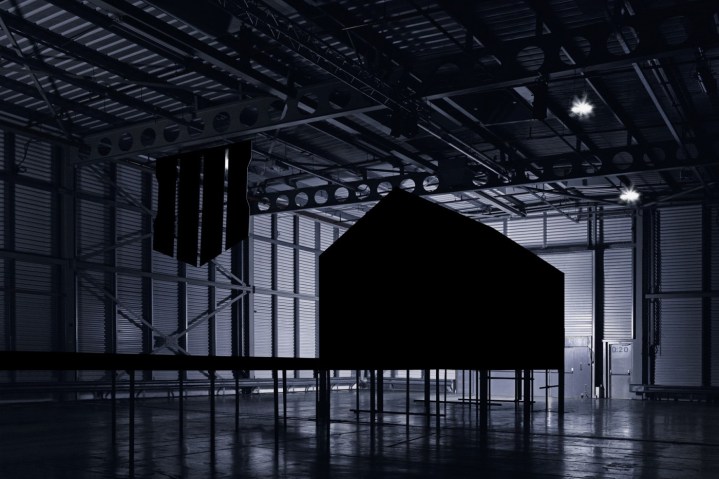
Have you ever gotten up to use the restroom during a movie screening, then struggled to find your seat when you re-enter the darkened theater? Now imagine how much tougher it would be if the theater wasn’t just dark, but literally the blackest black you’ve ever seen. Or not been able to see, in this case.
That’s the kind of disorienting effect that a major games developer recently turned to the U.K. company Surrey NanoSystems to create. And, boy, did Surrey NanoSystems deliver!
Whereas light normally bounces off surfaces, in the case of Vantablack it actually becomes trapped in it.
Surrey NanoSystems is the company behind Vantablack: a carbon nanotube material that’s capable of absorbing virtually all of the light that touches it. Whereas light normally bounces off surfaces, in the case of Vantablack it actually becomes trapped in it; continually deflected amongst a forest of vertical carbon nanotube until it finally surrenders and dissipates into heat. Approximately 99.965 percent of all visible light succumbs to this fate.
Since its invention in 2014, Vantablack has expanded beyond its original mission brief as a material for use in calibrating the cameras for satellites in orbit. Earlier this year, a version of the material called VBx2 was used to paint the outside of a large pavilion in South Korea for the Winter Olympics. This marked a major turning point.
“A few years ago it wouldn’t have been possible because of the huge complexity in making some of these materials,” Ben Jensen, Chief Technology Officer at Surrey NanoSystems, told Digital Trends. “But VBx2 is a material specifically designed for wide area application.”
That’s where the games publisher, Activision, comes into play. Literally. For the launch of its latest Call of Duty game, Black Ops 4, Activision decided that it was going to set up a warehouse in London. The idea was to give gamers the chance to try out the title in a setting unlike any that they had experienced before — and Activision knew exactly which company to call in for help.
“We had never previously done a room that was coated internally with Vantablack,” Jensen continued. “It’s long been a question that people have asked on social media. What would it be like to be in a room covered in Vantablack? As a result, when Activision approached us about this, the idea was very attractive.”
As requested, the warehouse was equipped with an additional indoor structure, painted with VBx2. Jensen noted that the process of doing this was somewhat different to the typical experience of painting an indoor space. “When you spray the material, it doesn’t spray down like a paint; it sprays down like a nanostructured coral,” he said.
The effect, though, was jaw-dropping. “If you have a look at a conventional matte black paint that you might have at home, its reflectance is typically between 4-7 percent in the visible spectrum,” he said. “The very best ones would be 4, and your typical one is more likely to be 6-7 percent. While these normal paints may look matte from head-on, however, when you look at them from sharp angles, they’re very reflective. Our coatings don’t visually change their reflectance from any angle. What that means is that when you coat objects with them, the objects lose a sense of shape and dimensionality. Your sense of it changes completely. It appears flat and two-dimensional, which isn’t something we’ve grown up experiencing.”

Transposed into a warehouse setting, with no lights other than the screen, he said the experience was akin to gaming in virtual reality. Players see only the large screen in front of them, floating in a blackness so intense that it’s not so much a color or shade as it is a hole in existence. Plus, without the benefit of wearing a headset, of course.
“It hadn’t been done before, so we didn’t know what the impact would be,” he explained. “We didn’t know if it would be a comfortable environment to play a game in, or whether it would prove too distracting. Based on all the feedback we’ve heard from people, they really enjoyed it. It’s totally different to anything they had experienced before.”
Players see only the large screen in front of them, floating in a blackness so intense that it’s not so much a color or shade as it is a hole in existence.
Don’t expect this to remain technology that’s trotted out only for one-off game launches, either. “[The success of this project had led] us to consider that there may well be applications in the wider gaming area,” Jensen said.
No, you probably won’t be getting an easy application VBx2 formula for painting your living room any time soon, but we wouldn’t be surprised to see more widespread examples of this technology, either.
A truly dark movie theater, for example? The next generation of ultra-immersive video arcades? Heck, a hotel room with real blackout blinds? “[We’re interested in clever applications in different areas where it’s designed to deliver maximum impact for people to experience,” Jensen said. “I think this has a whole lot of potential.”




